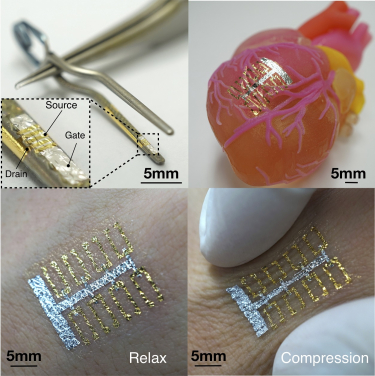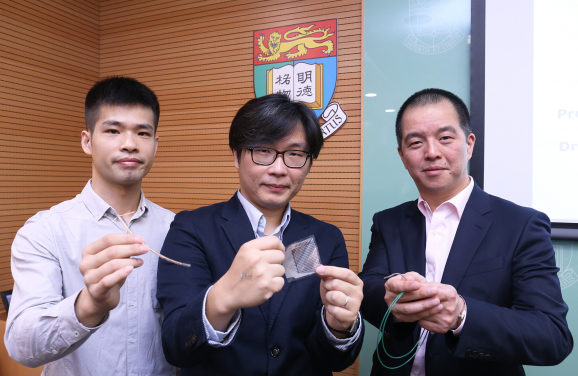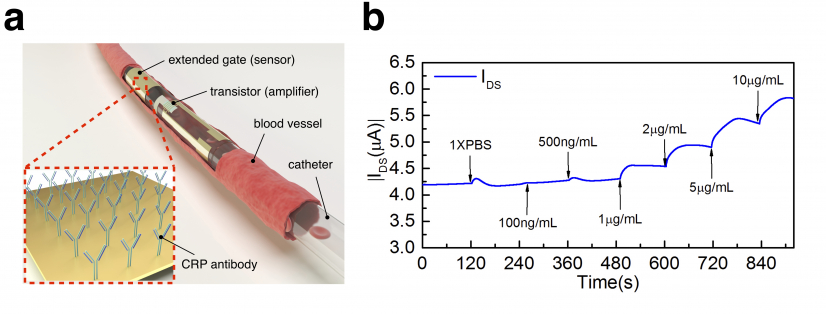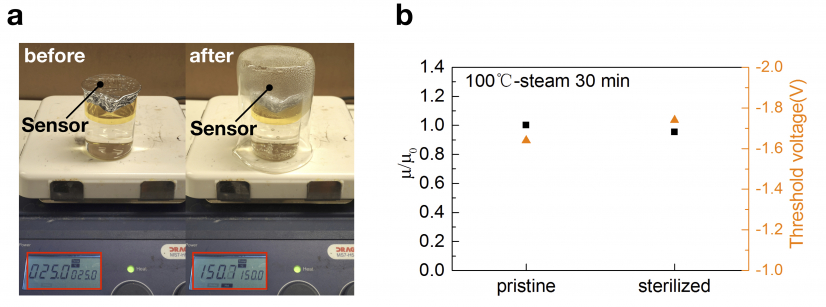Media
HKU Engineering and Medicine collaborate and develop a real-time ultraflexible sensor that makes inflammation testing and curing 30 times faster
05 Jul 2018

Figure 3. Demonstration of the transferrable property of device by transferring it to an aneurysm clip, an artificial heart as well as human hand. Scale bar is 5 mm and 500 μm in enlarged view.

Members of the research team (from left): Mr Ji Xudong, Dr Paddy Chan Kwok-leung and Professor Gilberto Leung Ka-kit.

Figure 1 a) Conceptual image of a CRP sensor in ventricular catheter implanted in blood vessel.
b) Transistor channel current increase against CRP concentration.

Figure 2 a) Photograph of OFET device before and during 100 ℃-saturated steam sterilization.
b) Normalized mobility and threshold voltage change after 30 minutes’ saturated steam sterilization.
- 1 / 4
- 2 / 4
- 3 / 4
- 4 / 4
Different from the inorganic counterparts like silicon, organic semiconductors can operate under bending or stretching. Usually a thinner film can have stronger capability to bend. Other than bending, a thinner or smaller device can also offer a faster response time which is particular important for sensor application if immediate information is needed. These ultra-flexible sensors are very popular research areas and their applications cover electronic, smart sensing and etc.
Recently, a University of Hong Kong (HKU) research team led by Dr Paddy Chan Kwok-leung of the Mechanical Engineering Department, in collaboration with Professor Gilberto Leung Ka-kit (Tsang Wing-Hing Professor in Clinical Neuroscience) and Dr Anderson Tsang Chun-on of Surgery, and Professor Xu Aimin of Department of Pharmacology and Pharmacy, have developed a C-reactive protein (CRP) sensor integrated onto a medical catheter for direct CRP sensing (Figure 1). This organic sensor has a total thickness less than one micrometer (~1/50 of Asian human hair), which can significantly save the time for sample and data collection, from currently a few hours to 10 minutes or less. In other words, testing and curing of inflammation can be speeded up by 30 times. The real-time signal read out has a great potential in allowing the doctors to take necessary immediate actions.
This mechanically flexible organic electronic device developed by Dr Chan’s team, as a demonstration of concept, is to measure the biological information in real-time. This device can sense the CRP level down to 1ug/mL, and hence more sufficient to deviate the health condition of the patients. The research finding was published recently in journal Advanced Science.
CRP level in the blood is an important indicator reflecting the level of the inflammation of patients. It is currently tested by blood analysis which cannot provide real-time information of the patients. In order to continuously monitor some proteins or biomarker levels in the human body, the common approach is to perform regular blood analysis every certain period of time. However, it would still need hours or longer to complete one test and no real-time information can be provided. The current organic device developed by Dr Chan’s team can measure the biological information in real-time with very little sample volume.
In the past, to develop an ultrathin device down to less than 1mm (~1/50 of Asian human hair) in thickness so as to allow conformal and flexible application, their fabrications were very challenging. These ultrathin devices are easy to crumple and break during the deposition and transfer processes. The deposition of the encapsulation layer to protect the device under extreme operating conditions such as high temperature, moisture, and etc is another hurdle.
The CRP sensor developed by the HKU research team is just one example to demonstrate the concept of the ultrathin devices. Other sensors such as neurotransmitter, and bacteria sensors can also be used. Other than the high sensitivity and fast response time, another major achievement of this ultra-thin and ultra-flexible sensor device is their compatibility with the standard sterilization processes adapted in the hospitals. Dr. Chan’s team has developed a “capsule-like” CTYOP encapsulation layer which allows the device to withstand high pressure, temperature and moisture environment. By using a CYTOP capsule with only 250 nm, this device can withstand boiling water or hot steam for more than 30 minutes without showing performance degradation (Figure 2). This sterilization compatibility makes the device an appropriate tool to be used together with surgical instruments in operation room which requires aseptic environment.
In order to transfer the sensors onto different medical devices, a PhD student of Dr Chan’s team, Mr Ji Xudong, adapted a hydrophilic-hydrophobic double layer plastic substrate which can be easily detached from the glass holder once in touch with water. Such floating properties make transferring the sensors onto different substrates or objects a lot simpler and more importantly, the device show no performance degradation after transferring among different subjects (Figure 3).
In the future, Dr. Chan and his team will further enhance the sensing power of the devices by integrating neurotransmitter and pressure sensors onto the catheter. The team will also develop a sensor platform for the clinical tests on animals. Other than the CRP sensor for the blood, the team also plans to measure other bio-markers especially the neurotransmitters or other information from the cerebrospinal fluid which can provide valuable real time information of the patients suffering from head injury or strokes. The team between HKU Engineering and Medicine is also aiming at developing a big data system to continuously measure and monitor various valuable biomedical information from the brain or other parts of the body. Once the data are becoming available by utilizing these low-cost sensors, the team is hoping the real-time measured signals can allow the doctors to take immediate actions to heal the patients.
Please click: https://doi.org/10.1002/advs.201701053 for the journal paper
X. D. Ji, P. C. Zhou, L. Zhong, A. M. Xu, A. C. O. Tsang and P. K. L. Chan*, “Smart Surgical Catheter Integrated with Imperceptible Organic Transistor for C-Reactive Protein Sensing”, Advanced Science, 5, 1701053, 2018.
For the powerpoint slides about this research, please click the following link:
https://drive.google.com/open?id=10pZVyJhnTIbUVfJUpaxIKvVzelnAVGSQ
A total of video clips can be found on p.3, 7 and 10.
(Please credit “The University of Hong Kong” if adopt the images and videos in the powerpoint.)
Media enquiry:
Faculty of Engineering
Dr Paddy Chan (Tel: 3917-2634; Email: pklc@hku.hk)
Ms Rhea Leung (Tel: 3917-8519/ 9022-7446; Email: rhea.leung@hku.hk)
Li Ka Shing Faculty of Medicine
Professor Gilberto Leung (Tsang Wing-Hing Professor in Clinical Neuroscience)(Tel: 2255-3368; Email: gilberto@hku.hk)
Communication and Public Affairs Office
Ms Trinni Choy (Tel: 2859 2606/ Email: pychoy@hku.hk)
